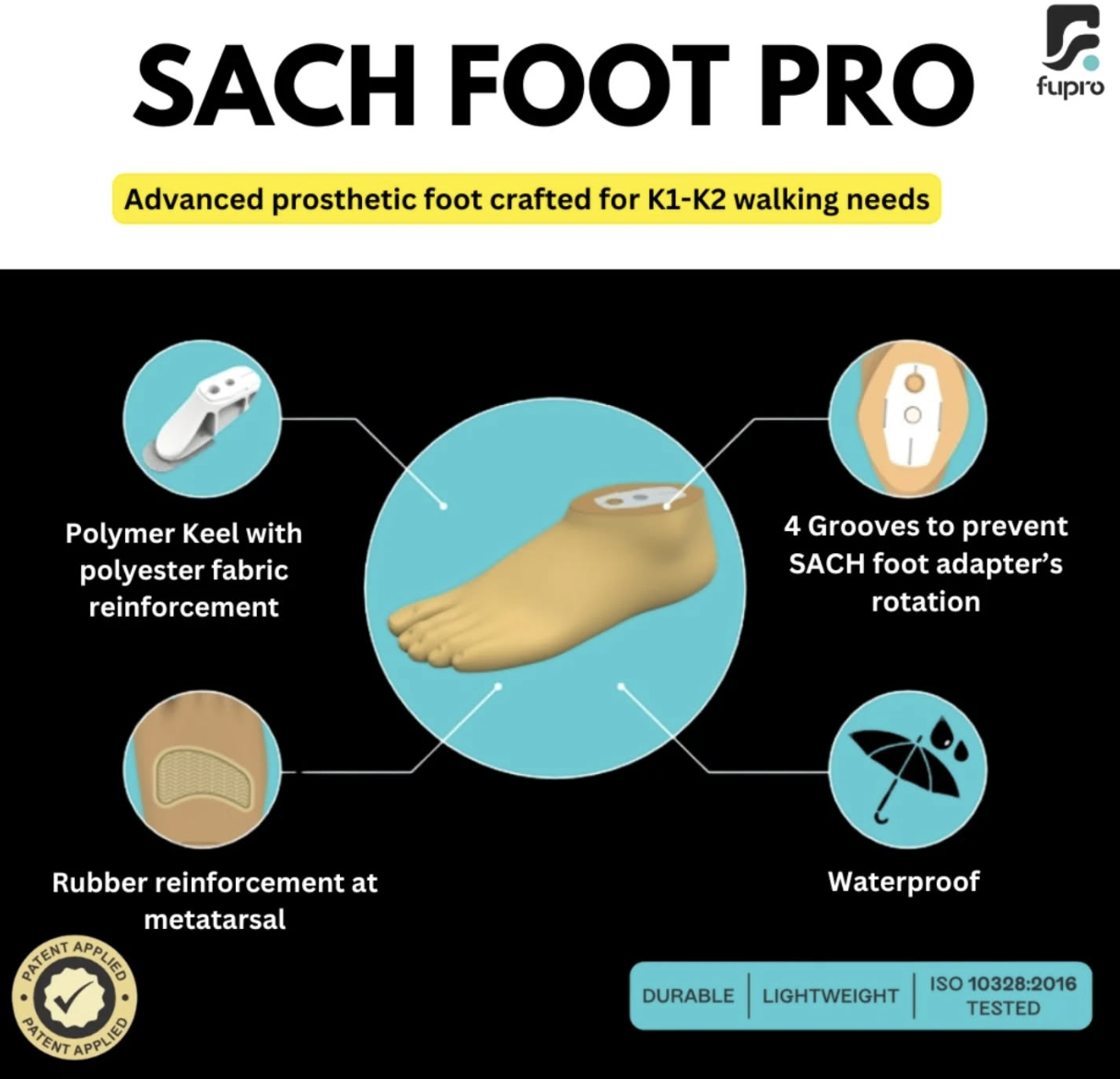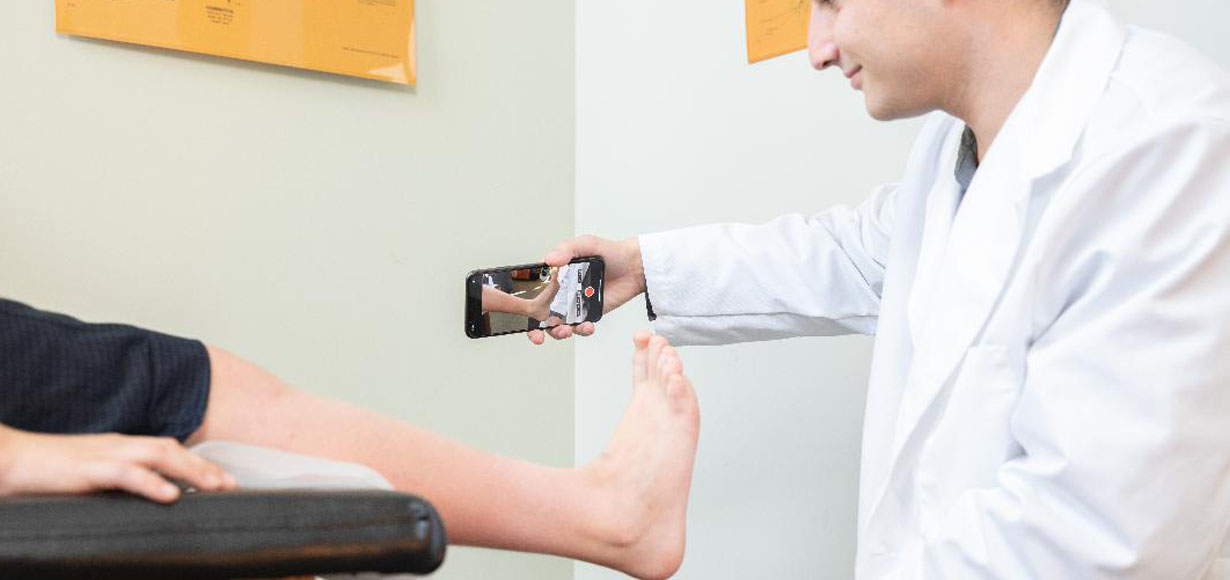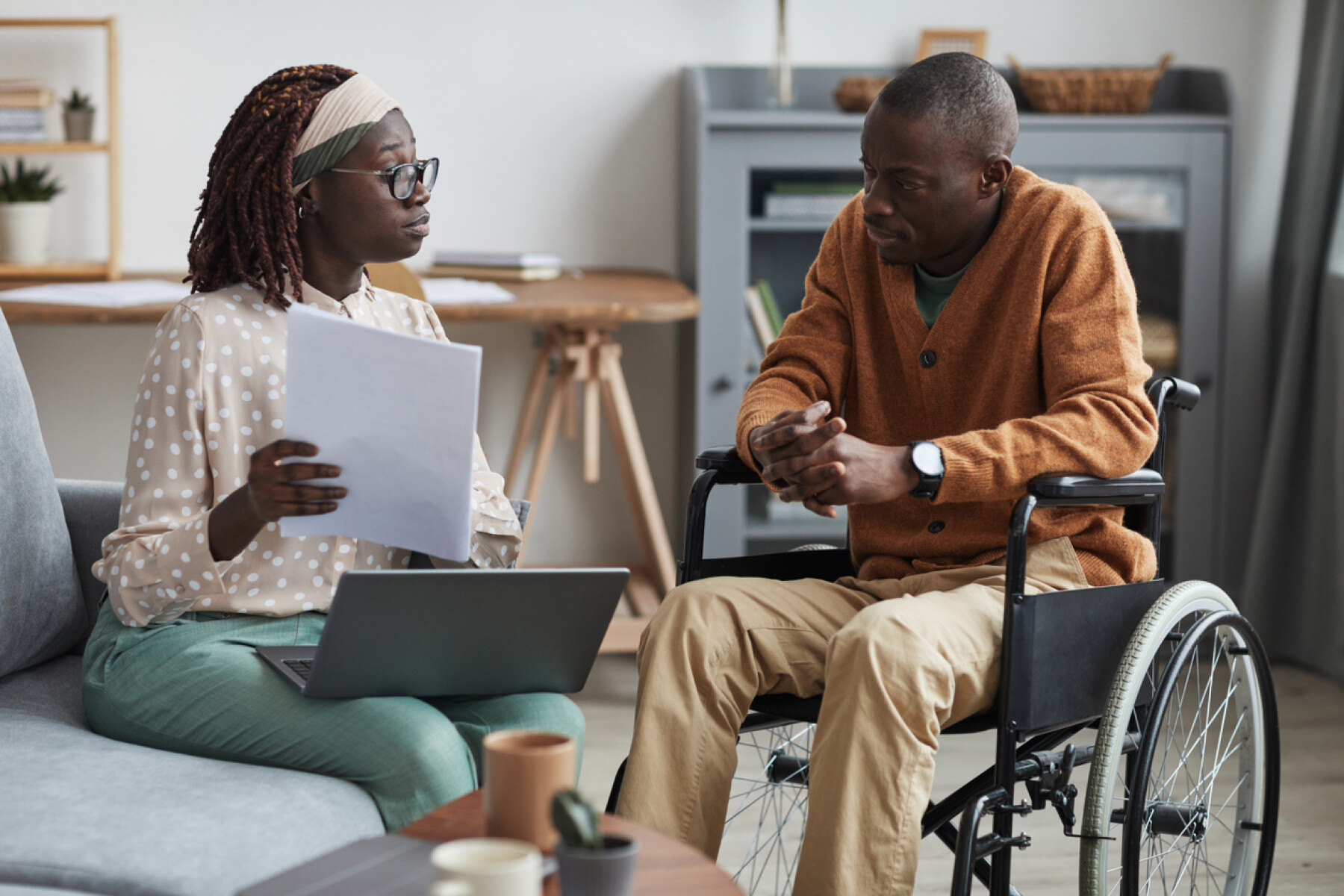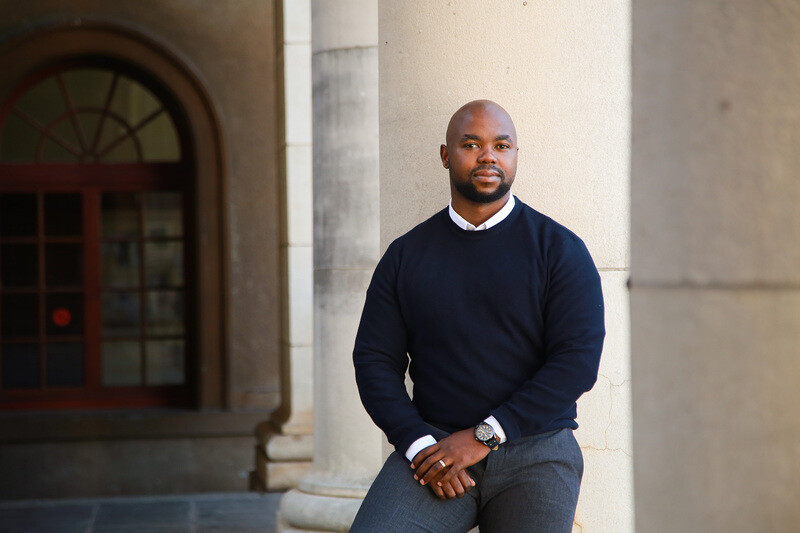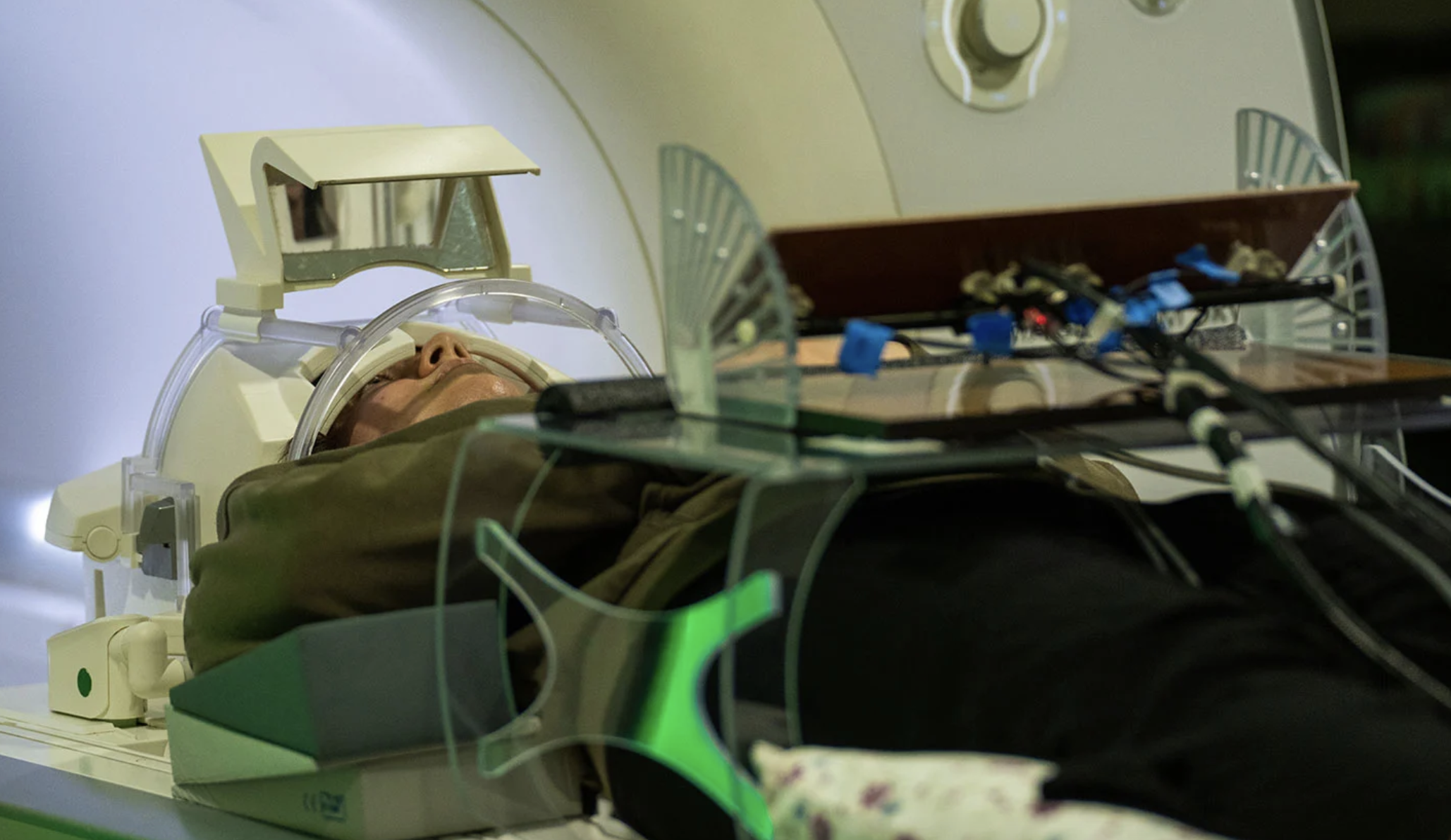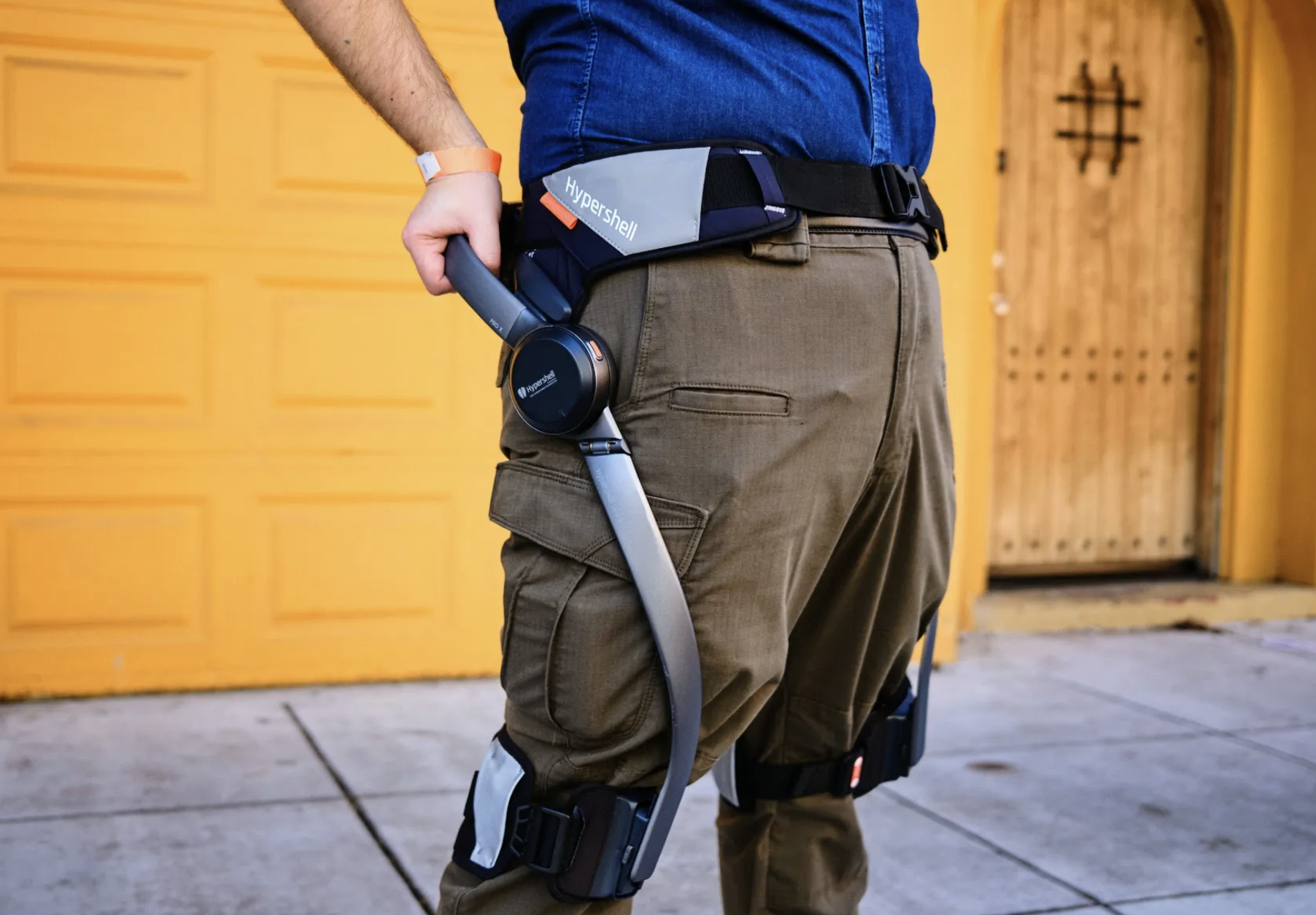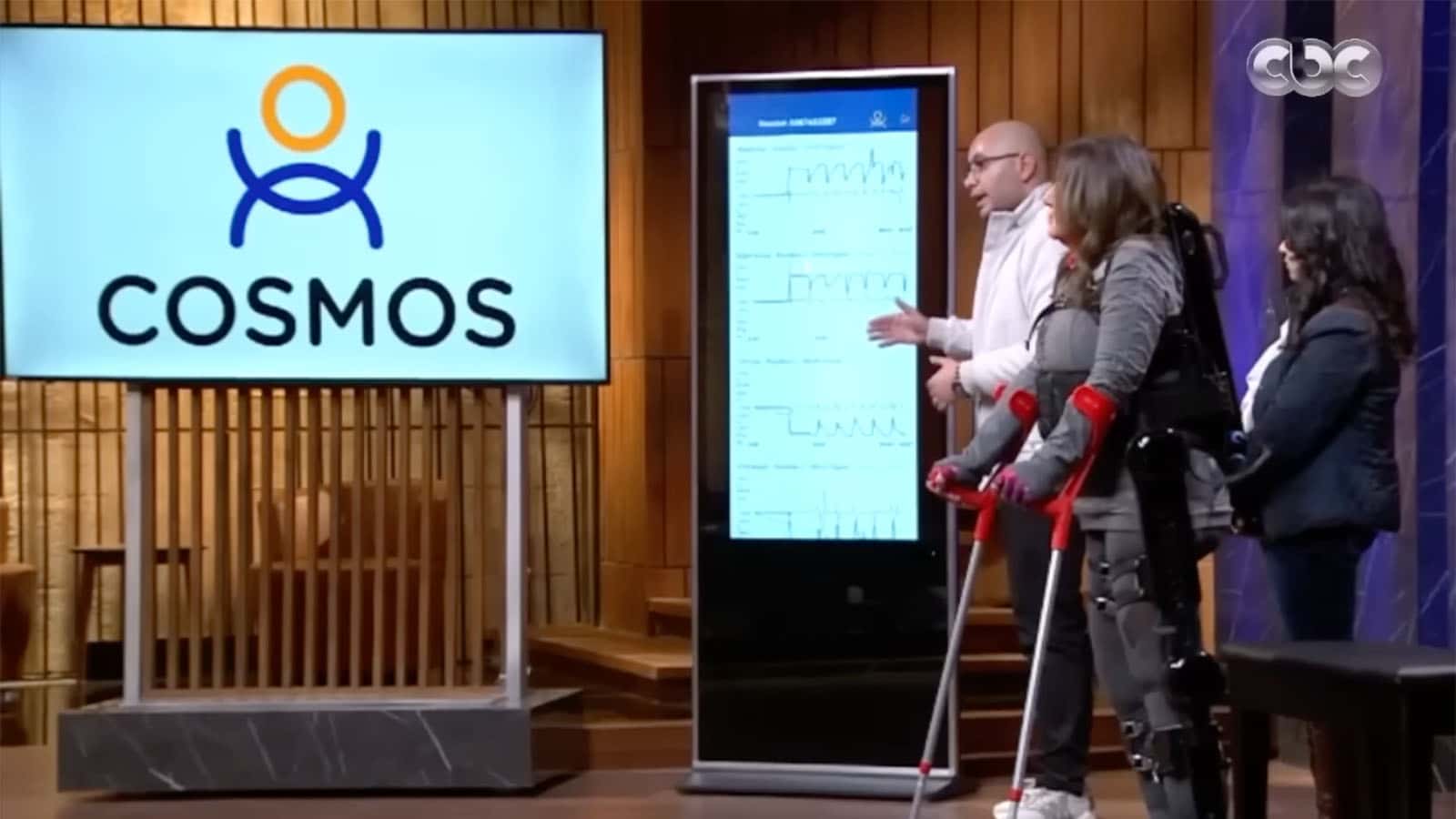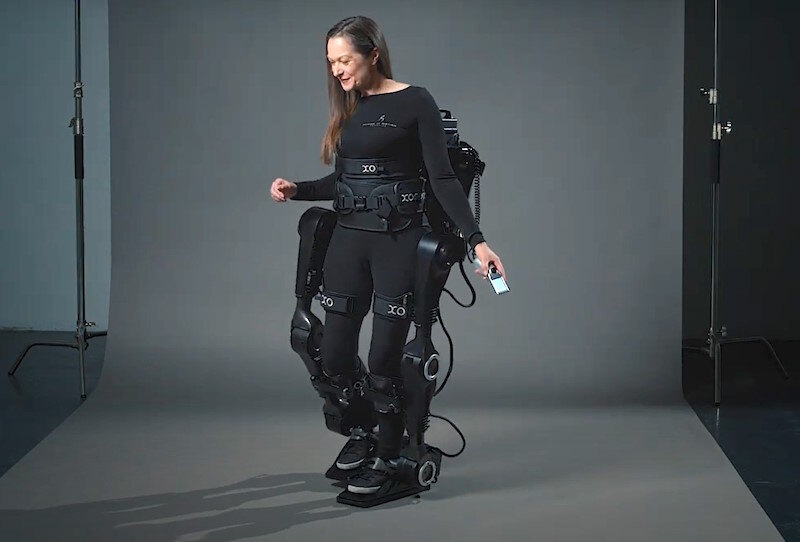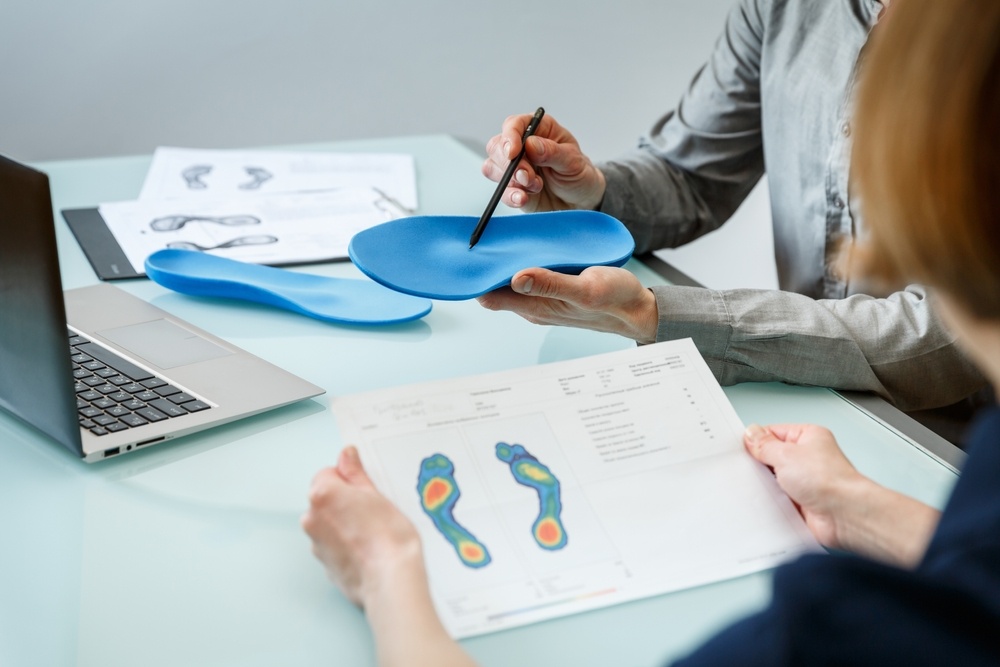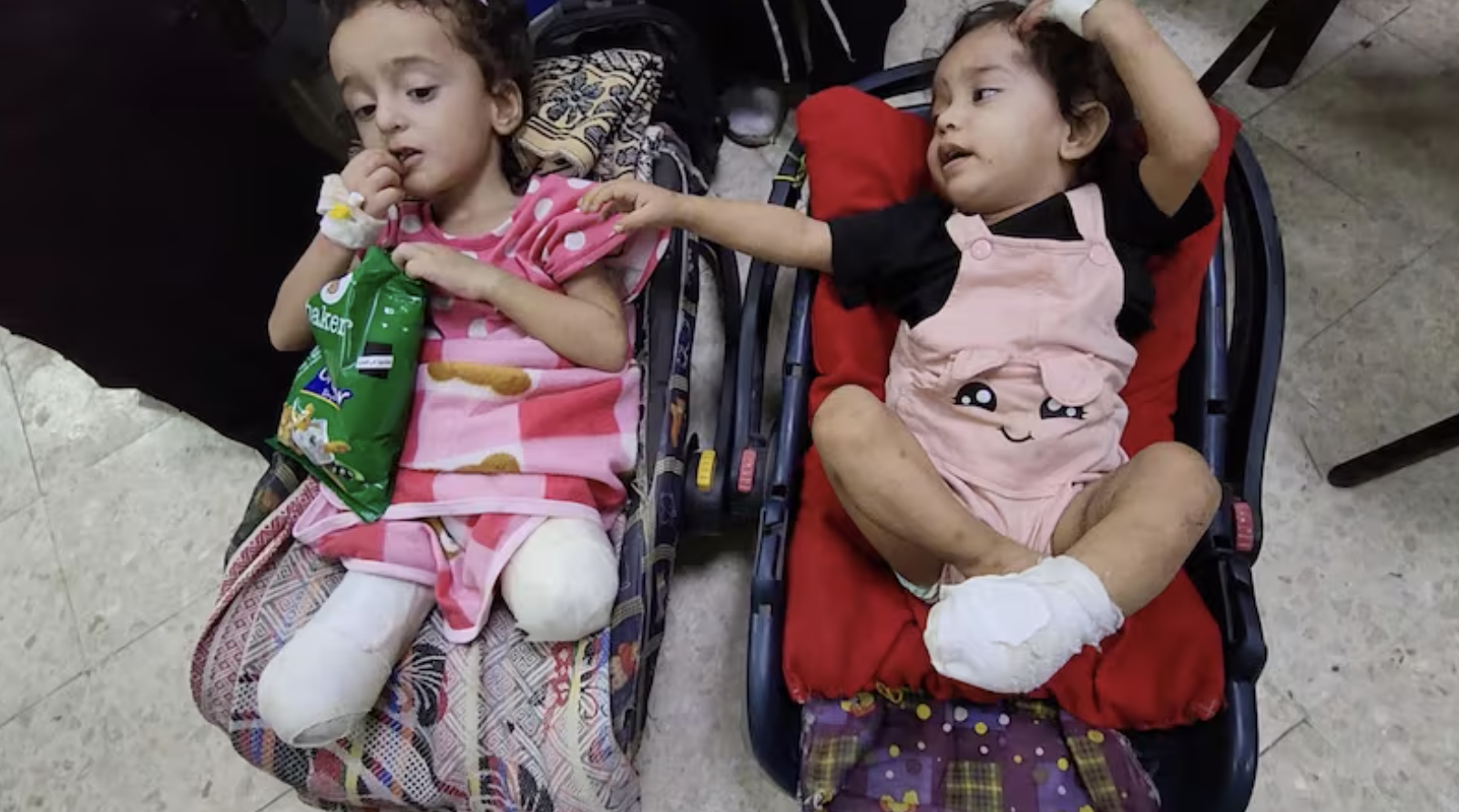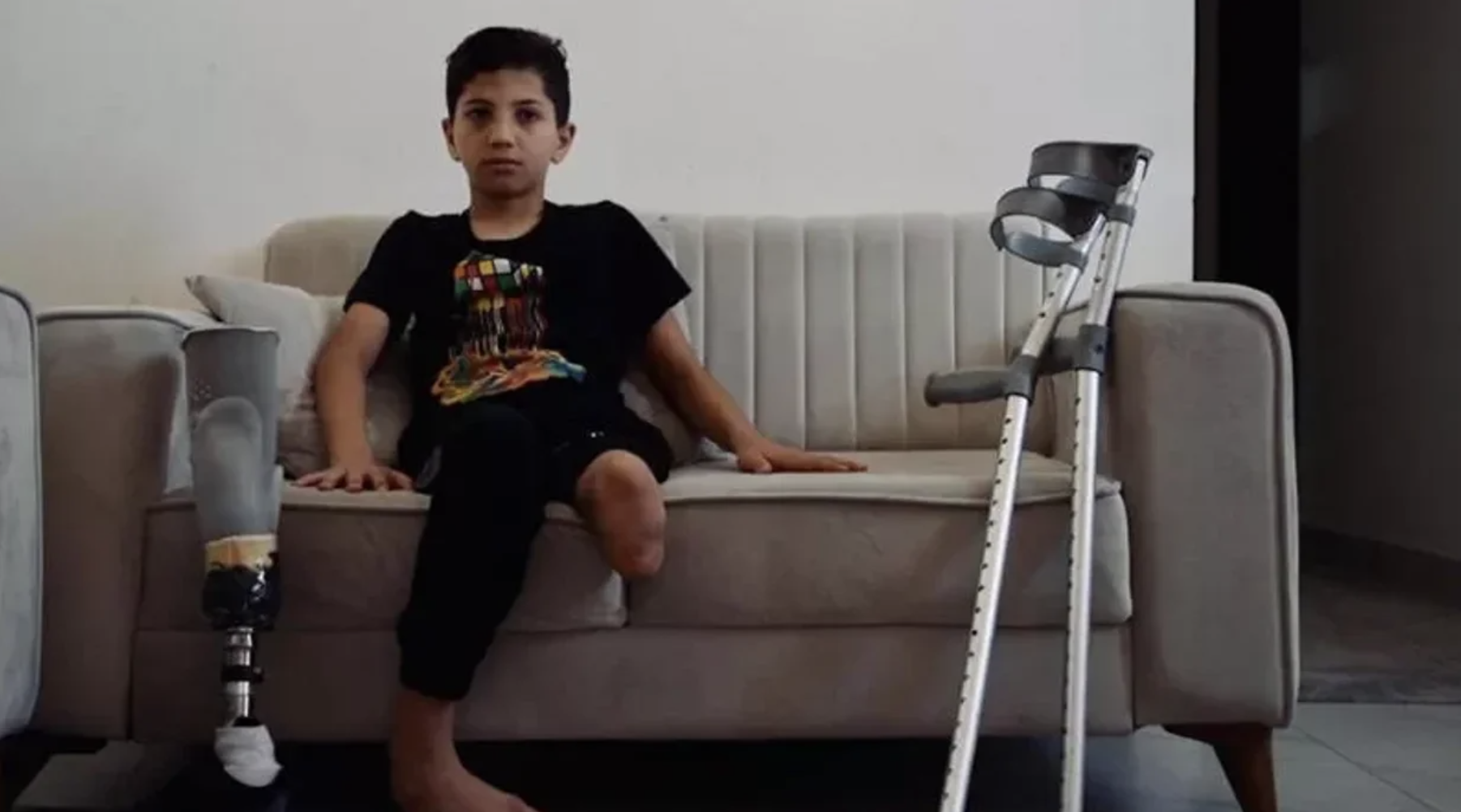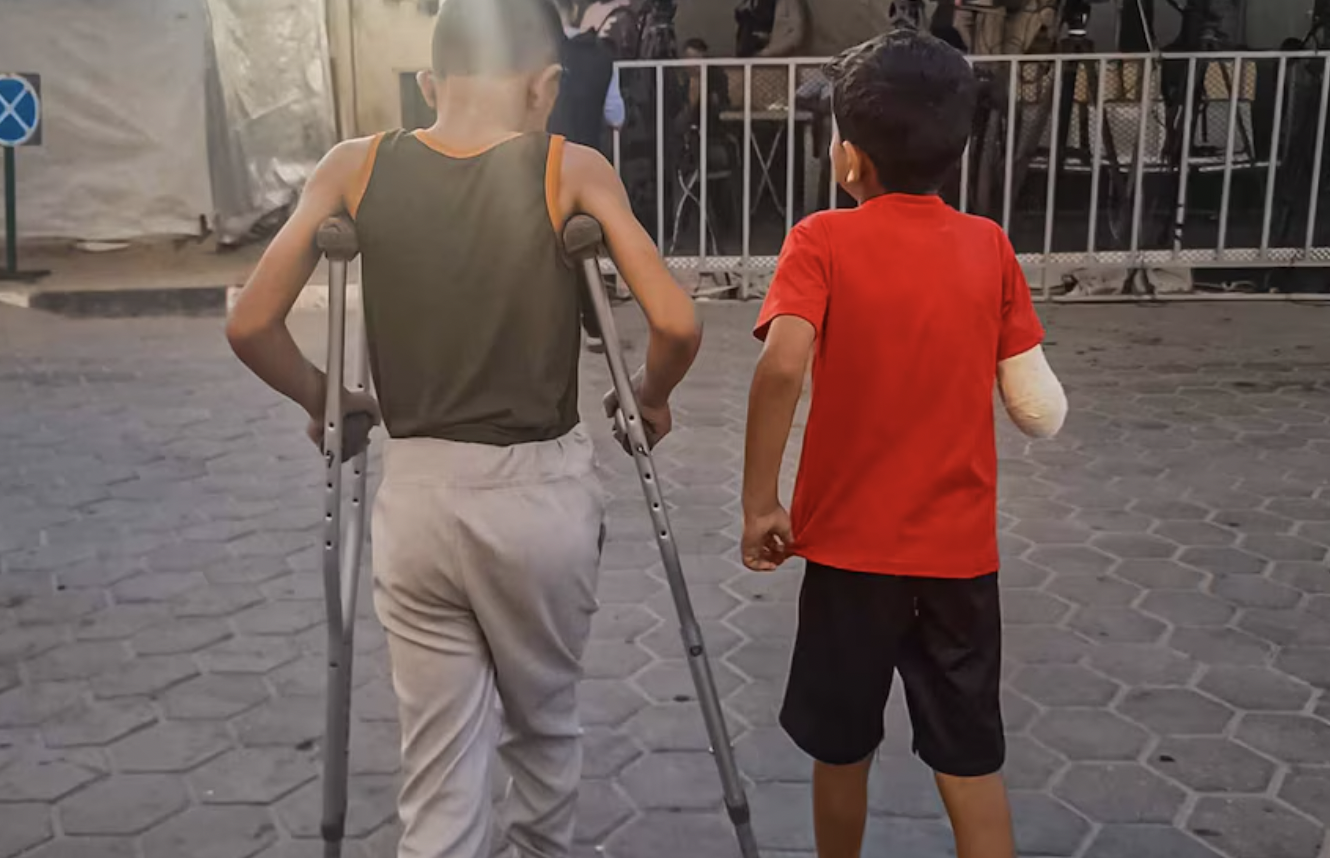Children as young as two who have lost multiple limbs. Others, treated only months before, returning to hospitals with injuries from renewed Israeli attacks. These are the scenes right now in Gaza, which the UN says has the largest population of child amputees in modern history.
Hundreds in the enclave will never walk, run, play football or swim the same way again and their lives will forever be changed by disability. While some children lost limbs in previous Israeli offensives on the strip, doctors say since the continuing war began on October 7, 2023, the number of amputations is unlike anything they have seen before
A child amputee in a wheelchair, in the partially damaged Al Shifa Hospital, in February 2024. The hospital in Gaza City was besieged by Israeli forces in October and November 2023. Anadolu
In June, the UN agency for Palestinian refugees, UNRWA, said 10 children per day on average were losing one or both their legs in the war. To date, at least 4,000 infants, children and adults across Gaza have undergone at least one amputation since the war began, doctors on the ground said.
Seeing a person maimed by the war in the strip has become increasingly common. “The eyes get used to them,” one humanitarian worker in Gaza’s north told The National.
Direct injuries from the Israeli attacks make up the largest percentage of amputations, doctors say.
“We often get patients who already have had their arm or one or both legs blown off in an Israeli attack – or had lost blood circulation to their limb because of how long they remained under rubble,” said Abdul Hameed Qaradaya, physiotherapy manager for Doctors Without Borders (MSF) at Nasser Hospital in southern Gaza’s Khan Younis.

He has been working in the field for 18 years - and had seen numerous cases even before the current war, in 2014 and 2018 - but nothing like what he is treating today.
“We’re seeing a new category of amputees. Children as young as two years old with double amputations and this is very rare [elsewhere in the world],” he said.

Rosalia Bollen, a Unicef spokeswoman who has been based in Gaza for more than two months, told The National it was very difficult to put an exact figure on the number of children who have had a limb amputated during the war.
“Unicef estimates that at least 23,000 children have been injured and, out of those, we estimate that at least a quarter [5,750] need major rehabilitation,” she said, which includes lifelong injuries such as severe burns, spinal injuries and amputations.
Ms Bollen said most of the children she met with one or more limbs amputated all had the same story: they were injured in an air strike while playing outside or in their home and were taken to hospital with a broken bone or shrapnel lodged in a limb. But there was no medicine.
“In any normal hospital, a child would receive an orthopaedic intervention, the doctor would try to fix the broken bones and the child would probably get antibiotics. The doctor would use sterile surgical equipment. That is the type of care a child would get,” she said.
“In Gaza, hospitals lack medical supplies, they lack medicines, equipment, anaesthetics, there’s a lack of doctors even.”

The UN official said one child she spoke to, Qamar, was admitted to a hospital in northern Gaza after her foot was injured in an air strike. When the hospital came under siege from the Israeli army for 20 days - meaning no medicines, food or water were delivered - the girl's leg became infected and the doctor was forced to amputate it.
Another girl, eight-year-old Ritaj, was at home in December 2023 when her home was bombed. Her family was killed but she was rescued from beneath the rubble with a foot injury. While in hospital, her leg also became infected and the doctor was forced to amputate beneath the ankle. In the weeks that followed, the infection spread and the doctor had to amputate it above the ankle. In July, the injury became infected again and the doctors had to amputate for a third time - this time at the knee.
“Under normal circumstances, there’s a good chance that these children would still have their legs,” said Ms Bollen.
Aid shortages worsen health crisis
Since Israeli forces seized Gaza's Rafah border crossing into Egypt, in May, aid deliveries into the strip have dropped by two-thirds, according to the UN.
Israeli restrictions on goods delivered into Gaza mean food, fuel, clothing and even tent supplies are not enough to meet the needs of desperate Palestinians. Any aid that does enter, rarely reaches the enclave's besieged northern region.

Israeli soldiers drive through a devastated Rafah in September 2024, four months after the army began their offensive in the southernmost city in Gaza. Reuters
At the few medical centres still open, there are shortages of everything, from the most basic medical supplies such as bandages, to more serious needs like surgical equipment that could save a limb.
And needs grow with every passing hour, Dr Qaradaya said.
“There are major shortages of wheelchairs and no prosthetics centres that cater to them. We sometimes have to make crutches from pieces of wood.”

Desperate Palestinians loot an aid lorry near an Israeli checkpoint in Gaza city, in February 2024. Israel prevents most aid from entering the besieged strip. Reuters
Before the war, 12 per cent of Palestinian children aged two to 17 faced one or more functional difficulties, while 21 per cent of households in the strip included at least one family member with physical or mental disabilities, according to Unicef. Despite the limited data currently available, estimates from doctors and aid workers on the ground suggest a significant increase in disabilities among children.
Services for people with amputations were already limited in Gaza before the war, with two rehabilitation and prosthetics centres serving the strip. Sheikh Hamad Hospital, which was established in 2016 and fitted about 150 new prosthetics a year, was severely damaged in the early stages of the war. The Artificial Limbs and Polio Centre provided services to more than 3,000 people a year, including 300 new prosthetics. In May, the UN’s OCHA reported the centre had not been damaged but was not accessible for staff or patients.

A patient with an amputated hand is fitted with a myoelectric limb at Sheikh Hamad bin Khalifa Al Thani Rehabilitation and Prosthetics Hospital in April 2022. Reuters
Dr Ahmad Al Absi, head of the prosthetics department at Sheikh Hamad Hospital, is working with Gaza’s Ministry of Health and international NGOs to create a plan for dealing with the higher-than-normal rates of amputations and people with permanent injuries in war.
“We are now just trying to perform life-saving surgeries because if we had to wait to treat and transfer the injured who are coming in by the dozens every day to specialised hospitals, they would die,” he said.
Many of these surgeries will have to be re-performed to either correct the previous operation or correct any complications that may have arisen from post-procedural infection or a mis-shapen stump. “They will need stump revision surgery,” said Dr Al Absi.

Dr Ahmed Ismail, an orthopaedic surgeon, carries out an amputation in Gaza to prevent the spread of an infection. Rakan Abed El Rahman / The National
Scenes of people who need assistance just to walk, which were once very rare before the war, are now all too common, he told The National by phone from the north of Gaza.
“Everywhere you look – there is someone on the street like this. Everyone has some sort of injury. There’s only so much we can do with what time and resources we have.”
The National spoke to three people in Gaza whose lives have been forever changed by the war due to amputation.
Hussam Jundia, a 38-year-old father of six, was about to set off to collect food for his family in February 2024 when he was hit by a drone strike that killed his uncles, cousin and injured his four-year-old son. It was the third time he had been hurt during the war. He lost his right eye, left leg at the knee and use of his right hand in the strike.
Mr Jundia says he is depressed and frustrated because he cannot provide for his family after being maimed by an Israeli strike. Rakan Abed El Rahman / The National
Before his injury, he provided for his family by collecting food and water but, today, he is reliant on a wheelchair for mobility.
“All I want to do is get a prosthetic limb so I can walk with my children like before and bring them food and drinks and play with them or help them collect the water, so they don’t get tired doing it,” he said.
“What have they done to deserve this? What has a boy like this, aged 8 years old,” he said, gesturing to his son, “done to deserve having to go collect water from here and there, to go collect food and I’m sitting here unable to do anything for them.”

Mr Jundia with his family at their home in Gaza. The father of six lost an eye, a leg and use of one of his hands in an air strike. Rakan Abed El Rahman / The National
The family struggles to buy enough food because of exorbitant prices, worsened by severe shortages due to the limited entry of aid, as Israel has only been letting in lorries that fulfil less than a day’s worth of needs compared to figures before the war.
“Everything has become so expensive. Sugar costs 50 or 60 shekels [about $15], flour is 150 shekels. It’s impossible now to buy it,” said Mr Jundia. “When I worked I could but now I tell you I can barely move and help my children. They do everything now. It’s humiliating.”
Deiaa El Edieny, 15, was playing the video game PUBG when the cafe he was sitting in exploded around him. The Israeli missile landed only 10 metres from him, he said, and the shrapnel tore through both his arms.
“I passed out and, when I woke up, I couldn't get up. I saw my arms were in really bad shape,” he told The National.
“I was able to get up and leave the cafe and sat by a sycamore fig tree until people came to help and took me to the hospital.”

Deiaa El Edieny, 15, had both his arms amputated after they were severely wounded in an Israeli air strike on a cafe in Gaza. Rakan Abed El Rahman / The National
His left arm hung by a piece of skin “and it was swinging … my arm was just a bone, there were no fingers or flesh.
“At the hospital, the doctor cut my left arm in front of me while I was awake and after four hours of trying to save my right arm, they had to amputate it too.”
Before his injury, Deiaa dreamt of being a photographer. He saved enough money by collecting and delivering water during the war to buy himself a camera “so I could practice on my own before I took any training courses.”
Today, one of his siblings, who lives with him in eastern Deir Al Balah, has to take the photos for him instead as well as help him get dressed, wash his hair or even hold a book.

Today, Deiaa relies on a sibling or has to use his feet to carry out simple tasks. Rakan Abed El Rahman / The National
Now Deiaa's dream is to leave Gaza to have prosthetics fitted “to be like a normal person”, to go out everyday with friends, swim and play with his dogs.
“When I was injured and went to the hospital, my dogs stayed at home. And when the Israelis entered our area, they killed my dogs. They kill people and dogs.”
On his double amputation he said: “It's something God gave to me, blessed me with, so I accept it.

Before his injury, Deiaa hoped to become a professional photographer but now needs help changing the settings on his camera. Rakan Abed El Rahman / The National
Shefaa El Dukee, 35, has become the caretaker of her nieces Misk and Hanan El Dukee.
Misk, who has just turned two, had to have her left foot amputated. Her sister Hanan, 3, has no legs at all. Their life-changing injuries were the result of an Israeli strike on their home in Deir Al Balah, which killed their mother and severely wounded their father on September 9.
“They feel like they lost both their parents, because their father cannot take care of them like he used to,” Ms El Dukee. told The National.

Hanan El Dukee, three, second right, had both her legs amputated above the knee, while her younger sister, two, in the foreground with her aunt Shefaa, has had a foot amputated at Al Aqsa Martyrs Hospital in Deir Al Balah. Rakan Abed El Rahman / The National
Both girls have yet to realise the full implications of their disabilities, but they are already struggling severely.
“They refuse to even look at their wounds. When I want to change their clothes, and I begin to undress them, Hanan would change her mind and tell me that she wants to sleep. She is sleeping to escape reality.”
Their extended family made an urgent application to have them treated abroad. But it has been more than two months with no progress.
“How long do we have to wait? Do they need to be clinically dead before they can be treated abroad?” Ms El Dukee asked.
Their recovery process has been difficult. The explosion propelled Hanan six metres away from their home, Ms El Dukee said. “They thought she was dead.”
“Her guts had spilled outside her body. And a CT scan showed that she had a fractured skull.”

Ms El Dukee and her niece Misk in Al Aqsa Martyrs Hospital in Deir Al Balah. Misk refuses to undergo physical therapy because she is in denial about her injury, her aunt says. Rakan Abed El Rahman / The National
Her sister had similar wounds and the bones in her foot were shattered. “The doctors kept recommending they eat proteins like chicken, milk and eggs. But they’re nowhere to be found - not consistently. And even if we did find them, we couldn’t afford them.”
Ms El Dukee fears the heartache the girls will face ahead.
“When we go home and they see the children around them running - playing hide and seek, or going outside, they will want to go out with them. I can’t bear the thought of how their heart would break when they go through this.”
Neglected needs and planning a better future
Well into the 14th month of the war, the needs of amputees are being ignored. Israel is still only allowing aid lorries into Gaza at a snail’s pace – not nearly enough to meet the requirements of hungry, cold and wounded people whose lives could be significantly improved with a warm blanket, a bag of flour or easy access to drinking water.
The average waiting time for aid lorries to enter the besieged strip is 74 days, the UN agency for Palestinian refugees told The National.

Lorries carrying aid queue on the Egyptian side of the Rafah border crossing, waiting to enter Gaza on September 9, 2024. Israeli authorities have severely limited the entry of aid into the strip. AFP
With so many basic needs not being met, items like wheelchairs are not prioritised, particularly as they take up more space than the remaining items and are not categorised as life-saving.
The components needed to produce personalised prosthetics for Gaza’s growing population of amputees are sometimes considered “dual use” by Israeli authorities and not allowed to enter the strip, for fear they could be used by Hamas to create weapons.
Even after the last gun falls silent, the work ahead in Gaza is monumental, not only because 60 per cent of Gaza’s structures have been destroyed but also because of the considerations that need to be made for inclusivity for the thousands of people who must try to live normal lives again, Dr Absi said.

Palestinians search for safety after fleeing the site of an Israeli airstrike in Jabalia in November 2024. AFP
“People want to live with dignity. They need a house that’s suitable. They need psychosocial support.”
Odai Jamal was four when he lost his right leg in an explosion in Jabalia, in 2004. He now works with the Palestinian Children’s Relief Fund (PCRF) in Gaza’s north, which helps people like him. Having struggled with his own injuries and lost his home during the war, he is all too familiar with the challenges ahead.
“We will need more lifts. We will need ramps and parking spaces designated specifically for people with special needs. We need to ensure that people with injuries like mine are prioritised and included in the job market. This was not something that was available to us before the war,” he said.

Pupils attend class at a UN-run school in Khan Younis in August 2019. Institutions across the strip, including schools, will need to be rebuilt with accessibility in mind. AFP
With a larger population of children now having to rely on crutches, wheelchairs or prosthetics, Mr Jamal said schools will have to become more accessible as well.
“It was difficult for me as a child and tiring to simply attend school or go up the stairs. Provisions need to be made for the new generation of students who will have to be given equal opportunities to learn just like their peers.”
Among society, views will have to change so that the bullying he endured as a child is not as common, he said.

Odai Jamal had his leg amputated as a child and now works with Palestinian Children’s Relief Fund to help children like him. Photo: supplied
Mr Jamal said he was often viewed as “less capable” than his friends, and frequently not chosen for football games, even after his prosthetic was fitted. He would hear adults whisper to his friends to “be careful” around him so that he does not fall or hurt himself while doing the normal things a child his age would do, as he grew up.
“The amputation was used as an excuse to isolate me.”
Now, this is not really an option anymore, he said.
“Every other household will have someone who needs special attention. The concept surrounding people with needs like mine will have to change about how capable we are, and how much we can be integrated into society.”

Palestinians who have lost limbs in Israeli attacks try on prosthetics at a centre in Rafah that is funded by Emirates Red Crescent in May 2024. Anadolu
Despite less than optimal conditions before the war, while Gaza was still under siege, some form of a treatment plan including psychological rehabilitation, extensive physiotherapy before and after a prosthetic was installed and follow-up appointments to check on the patient, were still available for amputees.
For now, all that is available to amputees is the immediate closure of the wound, some bandages to stop the bleeding, antibiotics and pain relieving medications, The National has learnt. “Beyond that, any follow-up treatment like physiotherapy is almost non-existent,” Mr Jamal said.
Technological advancements and help abroad
The UAE’s floating hospital in Egypt’s Al Arish, just outside Rafah provides high-quality treatment for amputees. It is a destination some patients reach after co-ordination with the Egyptian Health Ministry, approvals from various authorities, checkpoints and a border crossing into Egypt from Gaza. By then, the wound is already months old.
Such delays cause complications that professionals like Dr Mohammad Rashid Al Kaabi have to work through with the patients. Since opening a physiotherapy department in October of this year, the hospital has seen dozens of cases.

Doctors tend to a Palestinian patient from Gaza at the UAE's Floating hospital in Al Arish, Egypt. Chris Whiteoak / The National
“We begin with routine screening processes like X-rays and other imaging. Then we create a medical plan – with either surgery, physiotherapy or both,” he told The National.
“The people who arrive here have barely had basic services to fix their bones or disinfect the injury. So there are complications that take time and effort to deal with,” he said.
The injured arriving may have necrotic or dead tissue, or even a blood infection, which can cause sepsis and, if untreated, multiple organ failure. Patients may also have other infections caused by the organisms that are “multi-drug resistant” in their wound.
“Sometimes the bones are so fragile, like a biscuit. It makes it difficult to put a plate to connect bones. We have to use cement to bridge the bones instead. It’s a complicated process.”
Dr Al Kaabi, who has worked in infectious diseases and public health for 18 years, has seen injuries like this before, but “never at this scale”.
It is most difficult knowing that these complications could have been prevented, he said.

The UAE's floating field hospital in Al Arish, Egypt, treats Palestinian patients injured in Gaza. In October 2024, the hospital opened a physiotherapy department. Chris Whiteoak / The National
“There was hope for the patients in many of these instances. But the delay in managing the case causes that hope to be lost when the cure was easy and in hand if they had just been provided with the right healthcare or been allowed to reach it.”
Despite the challenges, the UAE floating hospital is integrating “robotic” prosthetics that are highly advanced and battery operated, giving the patient back some of their lost movements and allowing them to carry out some daily activities, as well as a qualitative overall treatment plan, he said.
Similarly, Dr Al Absi said he had been receiving calls from NGOs who are interested in offering their technologies to help the people of Gaza.
“We’re looking at the use of silicon limbs that would take a shorter time to make, and therefore be implemented at a higher pace.
An amputee is fitted with a prosthetic limb at the UAE field hospital in Rafah. Mohammed Abu Amra for The National
It is too soon to know the overall extent of the damage to ordinary Gazans who on top of hunger, the cold of winter and overall deterioration of health, are suffering from the mere act of surviving this war.
But the consensus among professionals remains that there is likely more life to live even after the loss of limb.


